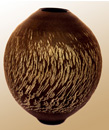KANNA
ca: KANNA
es: KANNA
 Kanna or tobikanna, Is a Japanese technique. It means “Leap of iron”
Kanna or tobikanna, Is a Japanese technique. It means “Leap of iron”
It’s a texture that can only be made as the work is turned on the wheel.
It creates an engraved continuous texture on a clay surface. Flexible metal tools are used and are held against the clay as the wheel quickly turns.
It is important to keep the clay in the correct state of moisture; if too soft the tool will enter into the clay too deeply and if too hard it cannot create a continuous pattern.
Working method;
When the piece has been turned and polished, center it again on the wheel. Holding the tool firmly between your fingers and with your arm firmly supported, start turning the wheel, indenting the tip of the tool. When you notice a strong vibration, you are creating a pattern with the Kanna method. Move the tool from the top to the bottom, changing its angle, the speed of the wheel and the pressure on the tool. They all affect the final result.
Since you cannot see the pattern that is being created because of the speed of the wheel, you may sometimes want stop the wheel to check the result. When you stop and restart, the pattern of the incisions changes, the texture is never the same when started again.
Decorative methods;
1) Apply slip over the piece, when it has lost its shine and can be touched without damaging it, put it on the wheel on a chuck and start to apply the tool at the top or bottom, starting gently.
2) Once the decoration on the clay is finished, oxides or slips can be applied into the grooves. When they are dry enough, go over the surface with a knife or very fine metal tool to clean up any roughness.
3) After being fired you can apply a coat of clear, transparent glaze that covers the surface to enhance the effects of the grooves and highlight the texture.
 Tools.
Tools.
You can make your own tools or purchase them.
The tools must be flexible enough to create the pattern with the movement of the lathe.
With tin shears and gloves, cut the shapes you need out of scraps of metal or can lids, flexible aluminum or steel, pieces of metal band.
Razor blades also work if one side is cut into a round shape. Cover the opposite side with insulating tape to avoid it being sharp and to be able to put more pressure when making the incisions.
Note: Be careful with the tools, so as to avoid cutting yourself. You must not forget you are decorating with sharp tools and with the wheel turning at maximum speed.
Advice.
It is not an easy decorative technique; it requires time to learn and to master the way to use the wheel and to use the correct tools. When one achieves the desired result, it vibrates like a piece of pottery. Every Kanna piece is different, it is almost impossible to create two identical pieces. The Japanese potter Shiga Shigeo was a great master of this technique.
Photos lent by: Nuria Pié, Shigeo Shiga, Ellen Rijsdorp, Monona Álvarez.
Link to author – Nuria Pié







